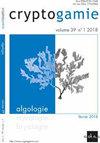The Culture Collection of Cyanobacteria and Microalgae at the French National Museum of Natural History: A Century Old But Still Alive and Kicking! Including in Memoriam: Professor Alain Couté
IF 1.5
4区 生物学
Q3 MARINE & FRESHWATER BIOLOGY
引用次数: 8
Abstract
ABSTRACT Cyanobacteria and eukaryotic microalgae are key players in life on Earth. They have adapted to a broad diversity of ecosystems, and ensure roughly half of the primary production. Their detailed study greatly benefits from isolated strains, deposited and maintained ex situ in culture collections, and made available to the scientific community along with expert knowledge. Established in the late 1920s, the culture collection of cyanobacteria and microalgae at the French National Museum of Natural History (MNHN) now comprises over 1350 non-axenic live strains isolated mostly from freshwater ecosystems in France. As a research-oriented collection, it contributes to biodiversity, taxonomy, genomics, and bioactive compounds research. Notably, the collection contains multiple strains of various genera of bloom-forming cyanobacteria that are of ecological concern, some of which produce cyanotoxins. Novel strategies for strain identification, conservation and accessibility are being implemented to provide an up-to-date resource to the community. Through research, expertise for ecotoxicology, partnerships with the industry or with artists, the MNHN collection appears at both a repository of biodiversity as well as resource for life sciences.法国国家自然历史博物馆的蓝藻和微藻培养收藏:一个世纪的历史,但仍然活着和踢!包括纪念:阿兰·考特考教授
蓝藻和真核微藻是地球生命的重要组成部分。他们已经适应了广泛的生态系统多样性,并确保了大约一半的初级生产。他们的详细研究很大程度上得益于分离的菌株,储存和保存在培养收藏中,并与专家知识一起提供给科学界。法国国家自然历史博物馆(MNHN)的蓝藻和微藻培养库建立于20世纪20年代末,目前包括1350多种非无菌活菌株,主要是从法国的淡水生态系统中分离出来的。作为一个研究型馆藏,它对生物多样性、分类学、基因组学和生物活性化合物的研究有重要贡献。值得注意的是,该集合包含多种菌株的各种属开花形成蓝藻是生态问题,其中一些产生蓝藻毒素。为了向社区提供最新的资源,正在实施新的菌株鉴定、保护和可及性策略。通过研究、生态毒理学专业知识、与行业或艺术家的合作,MNHN的藏品既是生物多样性的储存库,也是生命科学的资源。
本文章由计算机程序翻译,如有差异,请以英文原文为准。
求助全文
约1分钟内获得全文
求助全文
来源期刊

Cryptogamie Algologie
生物-海洋与淡水生物学
CiteScore
2.60
自引率
7.70%
发文量
11
审稿时长
>12 weeks
期刊介绍:
Cryptogamie is a fast-track and peer-reviewed journal of international scope publishing in English only. It accepts original papers and review articles on the taxonomy, biology and ecology of all cryptogams. An issue of Cryptogamie may be devoted to a single topic, under the responsibility of guest editor(s). All articles published in Cryptogamie are compliant with the different nomenclatural codes. A copyright assignment will be signed by the authors before publication.
Cryptogamie, Algologie accepts articles on systematics as well as ecology and evolution of any kind of algae (including Cyanobacteria).
 求助内容:
求助内容: 应助结果提醒方式:
应助结果提醒方式:


